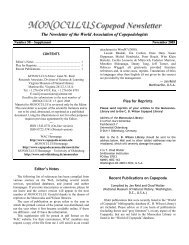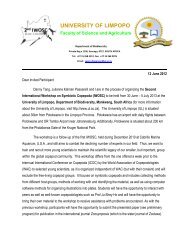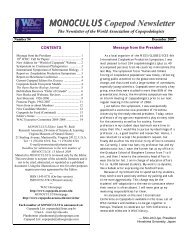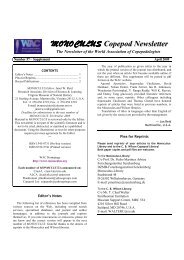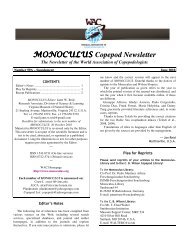development <strong>of</strong> a communications strategy and associatednetwork in order to keep interested parties informed <strong>of</strong>progress. One major hurdle in the process described above isthe establishment <strong>of</strong> a consensus concerning the best initialcopepod(s) species to be sequenced. Perhaps the bestapproach to such a problem is the establishment <strong>of</strong> anindependent committee supported by experts from withinand external to the copepodology community who maymake a balanced and informed decision on the community’sbehalf.Given the extended timescale <strong>of</strong> a full-genomesequencing project, no given copepod species can currentlybe considered to be substantially ahead <strong>of</strong> the field in terms<strong>of</strong> the availability <strong>of</strong> genomic resources or progress towardsa funded genome project, although some species do possessgenomic resources that may help to form the basis forprospective genome projects. For this reason the authorswould be delighted to receive comments, suggestions ornotes <strong>of</strong> interest from members <strong>of</strong> the community or toanswer questions relating to the establishment <strong>of</strong> or use <strong>of</strong>genomics or proteomic resources (no hate-mail please).― James BronUniversity <strong>of</strong> Stirling, Scotland (jeb1@stir.ac.uk)Grace WyngaardJames Madison University, U.S.A.(wyngaaga@jmu.edu)andStewart JohnsonNational Research Council <strong>of</strong> Canada(Stewart.Johnson@nrc-cnrc.gc.ca)ReferencesGregory, T.R. 2006. Animal Genome Size Database.http://www.genomesize.comHumes, A.G. 1994. How many copepods? In: Ferrari, F.D.& B.P. Bradley (eds.). Ecology and Morphology <strong>of</strong><strong>Copepod</strong>s. Proceedings <strong>of</strong> the Fifth InternationalConference on <strong>Copepod</strong>a. Hydrobiologia 292/293:1-7.————Dear Colleagues,In their letter, James Bron, Grace Wyngaard and StewartJohnson advocate the need for a dialogue for building thegenomics resources for copepod research. They alsoeloquently describe the criteria that should be used forselecting species for comprehensive genome and ESTsequencing projects. These include factors such as genomesize and complexity, wide geographic distributions tomaximize accessibility to investigators worldwide, andability to generate inbred lines. In addition to these criteria,we should also consider the specific questions or problemsthat we would like to address. Advances in functional8genomics are enabling us to move fairly quickly fromdescriptive genome sequencing to identifying the functionsand interactions <strong>of</strong> genes, conferring the ability to addressproblems across a wide array <strong>of</strong> disciplines in biology at amechanistic level.In this letter, we would like to share with you our plansfor sequencing the genome <strong>of</strong> the calanoid copepodEurytemora affinis. We first discuss why we chose thisspecies as a model organism, then we describe how thiscopepod genome project will facilitate future copepodgenome sequencing projects, and finally, we makerecommendations on how to build a community <strong>of</strong>researchers that could utilize genomic tools to address avariety <strong>of</strong> questions in copepodology. We highly encouragethe copepod community to begin discussing what othergenomic resources would benefit research in copepodbiology. Insights into morphology, ecology, and evolutionon copepods will be greatly enriched by having genomicresources for multiple copepod species.The copepod Eurytemora affinis serves as an excellentmodel for addressing fundamental questions in ecology andevolutionary biology, including those regarding adaptation,speciation, morphological stasis, niche evolution, biologicalinvasions, and host-pathogen coevolution. Eurytemoraaffinis is a key component <strong>of</strong> subtropical and temperateestuaries throughout the Northern Hemisphere. This copepodis a major grazer <strong>of</strong> algae and serves as a food source formany important fisheries. Within the past century, E. affinishas invaded freshwater lakes and reservoirs multiple timesindependently 1 . For example, E. affinis entered the GreatLakes ca. 1958, probably through dumping <strong>of</strong> ship ballastwater 2, 3 . These invasions have serious implications fordisease transmission, because E. affinis hosts a variety <strong>of</strong>potential disease agents, such as the pathogen Vibriocholerae.Because <strong>of</strong> the association between E. affinis and V.cholerae, The Institute for Genome Research (TIGR), aDivision <strong>of</strong> the J. Craig Venter Institute, is interested insequencing the genome <strong>of</strong> E. affinis. This sequencing projectwill probably begin in 2007. The copepod E. affinis is amain host <strong>of</strong> Vibrio cholerae 4-6 , but the nature <strong>of</strong> theassociation is not well understood. The riverine andestuarine bacterium V. cholerae causes cholera, an acute,diarrheal illness. In general, models <strong>of</strong> vector borne diseaseshave not been well developed in aquatic systems. Complexinteractions between E. affinis and V. cholerae might affectvirulence <strong>of</strong> V. cholerae. For example, chitin induces naturalcompetence in V. cholerae, allowing the bacteria to take upDNA from their environment and acquire genes necessaryfor virulence 7 . In addition, growth on chitin induces theproduction <strong>of</strong> toxin-coregulated pilus (TCP) by V. cholerae 8 ,which is critical for virulence. Also, the ability <strong>of</strong> V.cholerae to enter or exit dormancy might be related to the
association <strong>of</strong> V. cholerae with E. affinis, particularly whenthe copepods are in diapause. A comprehensive genomesequence and annotation <strong>of</strong> E. affinis would greatly facilitateidentifying genes and pathways that encode the mostrelevant traits, such as those associated with copepodphysiology and virulence. Because TIGR has alreadysequenced the genomes <strong>of</strong> several serovars <strong>of</strong> V. cholerae,we will be able to use entire genome sequences <strong>of</strong> both hostand pathogen to understand genetic responses <strong>of</strong> hostpathogeninteractions and the dynamics <strong>of</strong> this disease.Aside from host-pathogen dynamics, there are otherimportant questions that could be addressed using E. affinisas a model. For example, E. affinis provides an exceptionalmodel for exploring mechanisms <strong>of</strong> niche evolution.Phylogenetic analyses have revealed that freshwaterinvasions have occurred multiple times independently fromgenetically distinct saline sources 1 . Most notably, someclades have given rise to invasive populations, while othershave not 1 . Direct comparisons <strong>of</strong> source and invadingpopulations have revealed evolutionary adaptations that areassociated with habitat transitions 9, 10 . Analysis <strong>of</strong> multipleindependent invasions is beginning to <strong>of</strong>fer insights intorepeatability <strong>of</strong> evolutionary pathways and parallel evolutionacross independent invasion events 1, 10 . Finally, comparinginvasive and noninvasive populations is allowing us todetermine properties that are exclusive to successfulinvaders 10, 11 . The use <strong>of</strong> cDNA microarrays has allowed theLee Lab to analyze functional categories <strong>of</strong> genes associatedwith freshwater invasions by E. affinis 10 . A comprehensivegenome would allow us to determine the actual targets <strong>of</strong>natural selection during these invasions.Finally, E. affinis provides an excellent model forexploring patterns <strong>of</strong> speciation in copepods. Speciesconcepts are difficult to define among copepods, with manystudies showing lack <strong>of</strong> correlation between morphologicaltraits, genetic distance, and reproductive isolation 12-16 . Thus,the field could benefit greatly from integrating genetics anddevelopment underlying morphological traits with thegenomics <strong>of</strong> reproductive isolation. Like many copepods, E.affinis forms a species complex that displays jagged andidiosyncratic patterns <strong>of</strong> speciation 14, 15 . Patterns <strong>of</strong>molecular evolution, morphological evolution andreproductive isolation are completely uncorrelated anddiscordant 15 . Despite the extremely high levels <strong>of</strong> geneticdivergence among clades (up to 20% at COI), there is a highdegree <strong>of</strong> morphological stasis 15 . Moreover, there isreproductive isolation between genetically andmorphologically proximate populations 14 . Eurytemoraaffinis <strong>of</strong>fers an excellent model for the genomic study <strong>of</strong>speciation because they are easy to cross in the lab forstudies <strong>of</strong> reproductive isolation and possess a well-definedclade structure.9From a practical standpoint, E. affinis is one <strong>of</strong> the bestcandidates with which to begin a copepod genomesequencing project. It is tractable as a genomic model, andhas among the smallest copepod genomes (1C = 300 MB) 17 .The small genome greatly lowers sequencing costs andcomplexity <strong>of</strong> the assembly process, possibly allowing fullclosure and completion <strong>of</strong> the project to a ‘gold standard’level. This species does not possess chromatin diminution 17 ,a feature in some copepods where large fragments <strong>of</strong> thegenome are discarded from the presomatic line duringdevelopment. Extensive work has been devoted todeveloping culture techniques for this species, and as aconsequence it is readily cultured in a laboratory setting.Inbred lines <strong>of</strong> E. affinis can easily be generated, avoidingproblems associated with heterozygosity, which <strong>of</strong>ten plaguethe assembly phase <strong>of</strong> genome sequencing projects.Currently, inbred lines are being reared in the Lee Lab inpreparation for the genome sequencing project.In short, E. affinis provides an excellent candidate for acomprehensive genome project from multiple perspectives.However, if we want the entire field <strong>of</strong> copepodology toadvance and take full advantage <strong>of</strong> genomic resources, weshould not stop here. We describe the utility <strong>of</strong> choosing E.affinis as a model organism in order to illustrate the types <strong>of</strong>questions that we plan to address in a mechanistic fashion,using genomics tools. The availability <strong>of</strong> this genomesequence will make subsequent copepod genome projectsmuch faster and cheaper by providing the template forassembly and annotation. We hope that this example inspiresothers in the field <strong>of</strong> copepodology to think about theirquestions and about the best species that could be used toaddress those questions.As a community, we should begin discussing howgenomic tools could be used to address the most vexing andinteresting problems in copepod biology. For example,comparative genomics across multiple species could help usunderstand morphological evolution and elucidate problemsin morphological taxonomy. It has been demonstratedmultiple times that morphological characteristics areinadequate for defining many copepod species. In somecases, single gene phylogenies are inadequate, as well. Weneed to integrate our traditional methods with frameworksthat more accurately reflect the evolutionary history <strong>of</strong>copepod groups.The copepod community lags behind other communities(e.g., Daphnia, decapods) in employing genomicsapproaches. How do we train our community in this newarea? The copepod community needs a plan. GAW wouldlike to prepare a grant proposal to fund a training workshopand major symposium on a range <strong>of</strong> genomics topics toadvance the field <strong>of</strong> copepodology to be held at the 10thICOC in Thailand in 2008. We would like to hear from youabout your interest in participating in or attending such a



